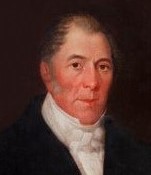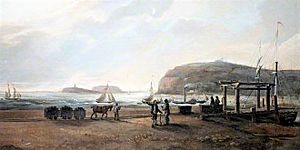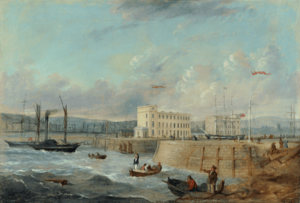George Insole facts for kids
Quick facts for kids
George Insole
|
|
|---|---|
 |
|
| Born |
Worcestershire, England
|
| Baptised | 5 December 1790 |
| Died | 1 January 1851 (aged 60) Crockherbtown, Cardiff, Wales
|
| Burial place | St Margaret's Church, Roath, Cardiff |
| Occupation | Colliery proprietor and entrepreneur |
| Known for | Pioneering development of the mineral resources of the South Wales coal fields |
| Children | James Harvey Insole |
George Insole (born 5 December 1790 – died 1 January 1851) was an English businessman. He built a huge coal mining and shipping company in South Wales.
George was born in Worcestershire, England. He was the youngest son of a farmer. With help from his family, he moved to Cardiff, Wales, in 1828. There, he started a business selling bricks, timber, and coal. By 1832, he was mining and shipping coal on his own.
He was a pioneer in selling steam coal from South Wales to London and other countries. His coal deals were so important that they helped make Lucy Thomas famous as "the mother of the Welsh steam coal trade."
Many believe Insole was the first to supply South Wales steam coal to London (in 1830), to other countries like Malta (in 1831), and even to the Royal Navy (in 1831). For many years, he shipped more steam coal from Cardiff than anyone else.
Early Life and Beginnings
George Insole was born in Worcester on 5 December 1790. He was one of six children. His father was a farmer. In 1819, George married Mary Finch. By 1820, he worked as a carpenter in Worcester. They had six children together.
In 1828, Insole moved to Cardiff. By late 1829, he teamed up with Richard Biddle. Their company, Insole & Biddle, sold bricks, timber, and coal. Family loans helped George start this new business. Biddle already sold "smokeless" steam coal from Waun Wyllt. This coal came down the Glamorganshire Canal from Merthyr Tydfil.
In 1830, Insole & Biddle shipped 414 tons of Waun Wyllt steam coal to London. This was a huge amount for that time. Even though they didn't make a profit on this first shipment, the coal became very popular. It was used in homes and by the Royal Navy. Insole also sold coal in places like the Severn Estuary and Ireland.

Becoming a Coal Producer
The Insole & Biddle partnership ended in early 1831. But George quickly got back on his feet. He also received a large inheritance that year. He continued to sell Waun Wyllt coal from his offices in Cardiff. His contracts helped make Welsh coal well-known in London. These deals also helped Lucy Thomas become famous as "the mother of the Welsh steam coal trade."
Many people agree that George Insole was a true pioneer. He was one of the first to export steam coal from Cardiff to London. He also sent it to places like Malta and Alexandria. He even supplied the British Navy.
In 1832, Insole leased the Maesmawr pit. This allowed him to mine and ship his own coal. When the Bute West Dock opened in 1839, Insole was one of the first to open offices there. In 1842, his son, James Harvey Insole, joined the business. The company became George Insole & Son.
By 1844, the Maesmawr coal seam was running out. So, they leased new collieries at Cymmer. In 1848, they opened 36 coking ovens. These supplied the Taff Vale Railway Company, which Insole helped start.
Until 1847, the Insoles mainly sold steam coal to coastal towns. These included places in the Bristol Channel (like Bristol and Gloucester), Cornwall (like St. Ives and Penzance), and Ireland (like Limerick and Dublin). Insole then expanded his business to other countries. He sold coal in France, the Mediterranean, Southeast Asia, and South America. He became the biggest shipper of steam coal in Cardiff.
In Cardiff, Insole was involved in the community. He supported British Schools and served as a town councillor for the South Ward.
Death and Lasting Impact
George Insole died on 1 January 1851, at age 60. He passed away at his home in Crockherbtown, Cardiff. He was buried on 7 January 1851, at St Margaret's Church in Roath.
People respected him greatly. He is remembered for helping South Wales steam coal become successful in London and around the world. The company he started continued to operate until 1940.


